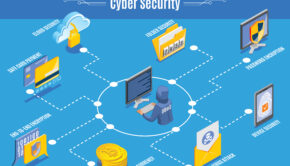Addressing Security Breaches and Vulnerabilities
Malicious cyber and security attacks are already a mainstay of an IT department’s risks to guard against. More than half of SMBs suffered some form of a cybersecurity breach in the last year. According to CNBC the average cost to fix such attacks costs the business $200,000 “And yet only 14% of SMBs are prepared to defend themselves from a cyber-attack and mitigate risk” and the reasons for that are smaller companies just do not put as much focus on cybersecurity protection. They are easier to penetrate because of weak passwords, web downloads, insider threats and less sophisticated firewalls and anti-virus software.
Larger companies may have better and more comprehensive data and network security systems, but their smaller vendors or partners may not. When we compare larger companies with 100m revenue plus 81% of them have a dedicated cybersecurity program in place whereas less than 66% of smaller companies with turnover of under $50m have such programs in their IT structure. The often held misconception is that attackers will not target their smaller enterprise because they have nothing of value worth stealing but that is simply not true as statistics show that 43% of cyber attacks target small businesses. (Fundera.com)
It is easy to understand why smaller companies focus less on IT security, after all, they may have limited manpower and finance to build a dedicated security team or department. Their focus may be more on bringing in sales or providing customer service so, security for their networks and data is seen as an unnecessary burden. So much so that the Governments around the world have had to put in legal directives for all companies to protect things like their customer data or stored financial information.
Another deficiency smaller companies tend to have is the, less than comprehensive review of, new technologies being adopted. Whereas larger companies will have vigorous vetting and testing of new technology, a smaller company may just implement without much thought for vulnerabilities and risks to their IT consulting.
Cyber Risks and Mitigations for Small Enterprises
It is clear that larger companies cannot leave smaller partners to their own devices when it comes to IT security. They have to work with suppliers, accountants, software vendors, logistics companies and manufacturers, so to safeguard their own systems, they have to assist and strengthen their partners’ security. Attackers are preying on the weaker defenses of smaller companies to get into the networks and databases of their large partners. It is in their own interests and there are many ways they can do this.
First, let’s look at the five main risks to businesses that can be addressed to improve IT security:
- Employee vigilance to cybersecurity
- Monitoring and renewing data security policies
- data encryption for sensitive information transfer
- A standard protocol for mobile devices especially personal ones that connect to the company network
- Data backup and recovery of data when lost.
By collaborating with their smaller business partners firms can plug a lot of these vulnerabilities and train them to be more secure. Secure private networks for third parties to connect to that are monitored by industry-level antivirus and anti-malware would reduce a lot of the risk from data transfer between companies. Also, secure logins that include multi-factor authentication like the ones Amazon use for marketplace sellers help limit the hijacking of accounts.
What else can SME’s Do to avoid Data Breaches?
Another thing small businesses can do independently according to digitogy.eu/fi to improve their IT security is to move more services to the cloud where the security features are better such as antivirus, data backup and network access. Cloud services from the big tech companies like Microsoft, Amazon, Google can be an affordable solution for SMBs as costs come down for licenses and IT maintenance can be provided as part of the software platform. Thus giving all companies the scale and expertise of these large tech experts. This is leveling the playing field for smaller businesses and giving them the technology and infrastructure to operate more like their larger partners.
Photo by Markus Spiske on Unsplash
















